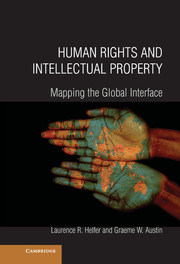Book contents
- Frontmatter
- Contents
- Preface
- 1 Mapping the Interface of Human Rights and Intellectual Property
- 2 The Human Right to Health, Access to Patented Medicines, and the Restructuring of Global Innovation Policy
- 3 Creators' Rights as Human Rights and the Human Right of Property
- 4 Rights to Freedom of Expression, to Cultural Participation, and to Benefit from Scientific Advancements
- 5 The Right to Education and Copyright in Learning Materials
- 6 The Human Right to Food, Plant Genetic Resources, and Intellectual Property
- 7 Indigenous Peoples' Rights and Intellectual Property
- 8 Conclusion
- References
- Acknowledgments
- Index
- Cases Discussed (Selected)
5 - The Right to Education and Copyright in Learning Materials
Published online by Cambridge University Press: 05 June 2012
- Frontmatter
- Contents
- Preface
- 1 Mapping the Interface of Human Rights and Intellectual Property
- 2 The Human Right to Health, Access to Patented Medicines, and the Restructuring of Global Innovation Policy
- 3 Creators' Rights as Human Rights and the Human Right of Property
- 4 Rights to Freedom of Expression, to Cultural Participation, and to Benefit from Scientific Advancements
- 5 The Right to Education and Copyright in Learning Materials
- 6 The Human Right to Food, Plant Genetic Resources, and Intellectual Property
- 7 Indigenous Peoples' Rights and Intellectual Property
- 8 Conclusion
- References
- Acknowledgments
- Index
- Cases Discussed (Selected)
Summary
Introduction
Conceptually and textually, there exist venerable connections between education and intellectual property. These connections are particularly clear in the copyright context, which is the focus of this chapter. The first copyright statute, the English Statute of Anne of 1709, was entitled “An Act for the Encouragement of Learning.” Similarly, the Copyright Clause of the U.S. Constitution empowers the U.S. Congress to “to promote the progress of science” (or, in modern parlance, “knowledge”) by creating a national copyright system. In the early years of the French Revolution, responsibility for the development of copyright law passed to the “Committee for Public Instruction,” and by 1793, it was accepted that “enacting a copyright law formed part of a grander scheme of public education.”
At the outset, it is necessary to distinguish between realization of the human right to education and the belief that copyright's role is to facilitate learning. Copyright protection has always extended to educational materials. Since its beginnings, copyright law has been premised on the idea that the flourishing of private markets in copyright-protected works will promote learning. In contrast, the human right to education imposes public law obligations on governments, including the provision of free educational materials (particularly to primary school children). The human right to education must therefore mean something other than the existence of markets for copyright-protected works, which anticipate that educational materials will be sold rather than distributed free of charge.
- Type
- Chapter
- Information
- Human Rights and Intellectual PropertyMapping the Global Interface, pp. 316 - 363Publisher: Cambridge University PressPrint publication year: 2011
- 1
- Cited by



